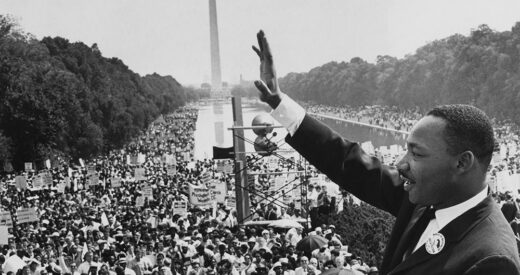“Mom, is there such a thing as a Black man?” my son asked. “What?” I said, “What do you mean by that?” “The Vice President said there’s such a thing as Black women. But is there such a thing as Black men too?”
On Saturday night, after a campfire and a long conversation about shooting stars, I curled up in my tent with my seven-year-old, hoping he would fall asleep fast and I could watch CNN on my phone. He didn’t, so I almost immediately gave in. “Hey, we found out who is going to be the next president, and that person is going to give a speech in a few minutes. Do you want to watch it with me, or do you want me to use my headphones so you can go to sleep?” Clearly, he chose screen time.
In general, my husband and I don’t talk politics around him. He learned about Donald Trump from his friends and he always goes to vote with us, but otherwise he is blissfully unaware. Let me stop here and say that I know that’s a privilege. Sheltering your children from what you don’t want them to know is a privilege of being white and middle class.
I keep my son sheltered from political discussion because I think that politics is grown-up stuff. In part, it’s also because I was an anxious child, and I want to spare my son the anxiety of knowing about big, scary problems he is too young to solve. I used to have nightmares about NAFTA when I was ten. Also, to name the elephant in the room, I was nervous about letting him watch those speeches because I knew they’d talk about gender and race.
See, here’s the clincher: we’ve never talked about race. We’ve talked about skin color but only a little and only when it’s a necessary descriptor. Mostly, my son is the kind of kid who describes people as ‘tall, with red shoes and a snappy attitude’ but rarely ever mentions their skin. It’s not that he doesn’t see it but that it has no meaning for him. He has no idea that people might call him ‘white,’ and until he heard Senator Harris say it, he had no idea that people might call themselves ‘Black’ either, despite a lifetime surrounded by people of color. He sees all people as shades of brown.
I have raised my son without racial labels. People come in all sorts of bodies. The end.
I tried to raise him without gender labels too, but the world took over. Much of that parenting was informed by one pivotal and, I still think, wonderful book that I read when my son was still a toddler: Parenting Beyond Pink & Blue: How to Raise Your Kids Free of Gender Stereotypes by Christia Spears Brown. In essence, Brown says, as soon as we label something and separate it into groups, our brains start ranking them. We start to believe our in-groups are better than our out-groups. We’re more likely to help people who are part of our in-group and more likely to believe social stereotypes about our out-groups, even when they don’t line up with our experience.
As Brown explains it, children latch on to whatever categories the grown-ups are using, including race, gender, height, size, ability, and etc., even if the group is based only on the color of t-shirts. My mom and I are on the red team? Ok, that must be the best one! The opposite is true as well; “If the adults ignored the groups, even when there were very visible differences, children ignored the groups too.”
So, I ignore race and gender in my language. I do not say ‘that little girl’ just as I would not say ‘that Black child.’ Instead, I say ‘that kid who sits across from you’ or ‘the child in the story,’ and I feel a flash of emotion every time his teacher says ‘boys and girls’ instead of ‘children.’
The difference is, we talk a lot about gender. We talk about sexuality too. He knows that gender is not binary, that you can love anyone you want to love, and that it’s wrong to assume you know a person’s identity just because of the way they look, act, sound, or dress. As a boy with long hair who loves cats and glitter, he has already experienced his full share of misgendering.
Watching Senator Harris in her victory speech, he seemed genuinely surprised to learn that she would be the first woman Vice President. “Has a woman ever been President though?” “Nope.” “But you mean just in America, right? Because I know there are women presidents all over the world.” “Yep.”
We talked about First Ladies too, and he was shocked to hear that none of the former Presidents has ever been married to a man. He genuinely believes that everyone has equal chances. I love that about him, but I know it needs to change. I know I need to change it. I know it has just started changing.
We talk about gender and sexuality but we don’t talk about race.
In raising my child to be free of stereotypes, to believe that every person has equal value, I have also convinced him that every person has equal opportunities as well. I have left him without the language he needs to respect identity, to acknowledge historic and existing systemic inequities, and to examine his own unconscious biases. Jennifer Elberhardt says it beautifully in her essay for LitHub, where she basically sees right through to my soul: “When we’re afraid, unwilling, or ill equipped to talk about race, we leave young people to their own devices to make sense of the conflicts and disparities they see.”
In essence, I took the easy way out.
Research involving this sort of blindness is overwhelmingly clear: refusing to acknowledge race or gender perpetuates systemic inequality. Even a decade ago, Tolerance Magazine was calling colorblindness a new form of racism through which “folks who enjoy racial privilege are closing their eyes to the experiences of others.” The support is ubiquitous. A study from Ohio State even breaks down “the four types of color blindness,” including the low prejudice, high awareness type of which I am guilty. When he was three and four, it felt like the right thing to do but the truth is, I knew better. I didn’t have the words to explain race and racism, so I ignored them instead.
As someone who works in DEI, I feel embarrassed and ashamed to admit that.
The good news is, he’s only seven and now I know what to say. In fact, there are a huge number of resources teaching me how to have these conversations, a few of which are attached below. Perhaps this is the beginning of my son’s long journey toward understanding unconscious bias, privilege, and equity. I hope he will learn to use his own behavior, power, words, and convictions to create a world that looks more like the one he already thought existed. I know that’s quite a marathon to ask for, but I am grateful for the starting line.
Senator Harris, thank you for shaking us up. As you said on Saturday, now is when the good and necessary work begins.
Resources
Celebrating Skin Tone by Katharine Johnson
When Colorblind Parenting Meets Anti-racism by Zeresenay Alemseged
Raising Race Conscious Children by Beata Mostafavi
Talking to Children About Racial Bias by Ashaunta Anderson and Jacqueline Douge
Unconscious Bias – The Secret Disruptor course by The Diversity Movement






